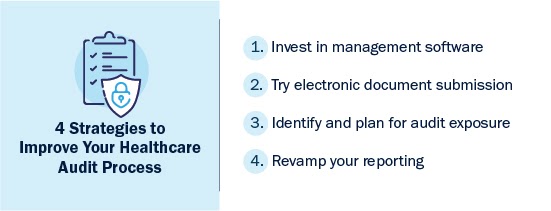4 Strategies to Improve Your Audit Process in 2021:
At this point, you’ve probably read dozens of end-of-year articles trying to sum up the strangeness and unexpected twists we faced in 2020. Rather than dwell on what we’ve faced this year, we’re looking forward to rising above and charging into 2021 with renewed vigor, determination and, most importantly, an improved healthcare audit process.
If looking for a better way to handle the ins and outs of healthcare audits is at the top of your New Year’s resolution list, you’ve come to the right place. Today we’re sharing four strategies to improve your internal systems and limit financial exposure from healthcare audits in 2021.

1. Implement a backbone platform
A “backbone platform” is a technology-based solution dedicated to managing your audit response process. A good software solution will integrate your health system’s data and leverage it to increase overall efficiency through automation.
Anyone who has responded to an audit knows the process is multidisciplinary, involving many hands from different departments. In a traditional process, someone receives the audit letter and sends the details to the records department and off to the parties involved in gathering required information. Then, after all information is gathered, another person compiles it and sends it back to the auditor. When every piece of the process is handled by a different set of hands, the risk of a mistake rises exponentially.
To increase the complexity of the process, many health systems traditionally have different processes and involve different departments depending on the source of the audit: Medicare, Medicaid or commercial insurance companies.
The proliferation of workflow management systems and related software systems means that mistakes are fewer and further between. An audit backbone brings all audit workflows into one system and keeps everything in order. Investing in management software in 2021 can make all the difference in identifying your financial exposure and determining your team’s effectiveness in protecting reimbursement.
2. Try electronic submission of documentation
When it comes to document submission, the equivalent of passing off audits by hand is submitting hard-copy documents via mail or shipping CDs with scanned files. The majority of commercial auditors have portals for document upload, but this still comes with its own challenges. If multiple people in your organization are uploading documents, it’s difficult to track activity and keep an accurate count of what has already been submitted. And if you have 10 different payers with 10 different portals for audit documentation asking for information all at once, you’re at huge risk of a mistake.
If you’re still sending documentation through the mail, it may be time for an upgrade in 2021. Leveraging electronic document communication between your organization and the auditing party can save valuable time and money. It can also increase security and compliance and help your organization find its footing in a newly remote world perpetuated by the events of 2020.
This change to electronic documentation has become easier to implement since the release of the esMD Gateway system. Providers can contract with a certified health information handler or develop their own Medicaid submission capability with guidance from the Centers for Medicare and Medicaid Service. But on the Medicaid and commercial side, you’ll need to work with individual payers and auditors to integrate them into a portal based system you create, or ask for their electronic documentation options.
Of course, many of the backbone solutions we discussed above include a system for easy document submission. Investing in such software is a simple workaround to the complex world of developing and integrating your own electronic submission capability.

3. Identify your COVID-19 audit exposure
The COVID-19 pandemic caused confusion and chaos in the American healthcare system early in 2020. So much changed quickly, opening the door to potential errors that auditors are now looking to correct.
One specific area especially susceptible to error was telehealth and the coding of telehealth visits. Many patients with suspected COVID symptoms began explaining their symptoms over camera rather than in person. Coding was already complicated before we introduced a global pandemic, and few medical personnel had time to sit down and fully understand how to code COVID-related remote appointments while in the thick of managing the initial surge in cases.
There has been a consistent feeling of uncertainty around what the post-COVID audit world would look like after so much emergency treatment and intake. While we still aren’t fully sure how aggressively payers will begin implementing audits in 2021, health systems can still prepare for the possibility of increased audit activity.
Start the new year by preparing yourself. If you were aggressive in telehealth visits, you may face some exposure as it relates to the coding of those visits. Identify at risk claims and keep track of your potential exposure month after month. And we may sound like a broken record, but again, investing in a backbone platform and keeping the audit process in order can prepare your staff for handling any potential increase in post-COVID audits.
4. Revamp your reporting
Oftentimes we see health systems running reports to review and correct past problems. But going into 2021, you may want to consider rethinking your view on reports as a tool. Keeping track of your data and comparing it month over month helps you stay on top of current trends and any increases in financial exposure, new audits and lost reimbursement.
While we mentioned there is a chance of an increase in telehealth-related audits in 2021 due to COVID, there’s also a chance an audit increase could spring from somewhere unexpected, as we’ve seen before. For example, health information management professionals may recall the blanket increase in audits related to cataract surgery back in 2019.
Take account of the services you provide and keep track of audit-related trends coming down the pipeline. All Medicare audits are posted on the CMS website, so check it often and cross reference it with your internal reports. If CMS is posting an increase in telehealth audits and you know that, first, you saw a huge increase in telehealth appointments last year, and second, your reports show you haven’t experienced huge success in protecting reimbursements from telehealth audits, you know where to concentrate audit response resources in the near future.
Leveraging technology to improve audit process success
Bluemark is proud to offer an ideal backbone platform solution for audit management with Blueway Tracker. Blueway Tracker’s industry-leading capabilities manage the response process of all types of audits including those from Medicare, Medicaid and Commercial Payers. This software brings improvements in case management, claims and remittance file interfacing, payer contract tools, release of information, and reporting. It also includes the option of Full Cycle esMD which provides direct electronic document transmissions through CMS’ esMD Gateway.
If investing in technology to improve your process is at the top of your list of New Year’s Resolutions, Bluemark is here to help. Our software demonstration can show you how each of Blueway Tracker’s features will work to meet your organization’s specific needs.




